Ο26Georges MathieuPetite Torture infligée au Marquis de Coconat et à son complice la Môlesigned 'Mathieu 60' lower right; further signed, titled and dated 'Petite Torture infligée au Marquis de Coconat et à son complice la Môle. Mathieu 1960' on the stretcher oil on canvas 250 x 300 cm (98 3/8 x 118 1/8 in.) Painted in May 1960. This work will be included in the forthcoming catalogue raisonné, currently being prepared by Le Comité Georges Mathieu under no. GM60038, and is accompanied by a certificate of authenticity issued by Le Comité Georges Mathieu Full CataloguingEstimate £250,000 - 350,000 ♠ Place Advance BidContact Specialist Kate Bryan Specialist, Head of Evening Sale +44 20 7318 4026 kbryan@phillips.com
Overview With its hoisting, arcing and expanding black lines, as well as its timid passages of red and blue paint, Petite Torture infligée au Marquis de Coconat et à son complice la Molle forms part of a series of large paintings that the French artist Georges Mathieu conceived in 1960, on the occasion of his exhibition De quelques pompes et supplices sous l’ancienne France, taking place at the Galerie Internationale d’Art Contemporain, Paris, from May to June 1960. ‘The exhibition Pompes et Supplices sous l’ancienne France tackled the theme of The Feast, The Party’, writes Francois Mathey. ‘The Pumps [Pompes], which were both festive and funeral, were the occasion for the exaltation of life and death. The party, as paroxysm of life; torture, as paroxysm of physical suffering. Joy, sadness and moral or physical pain being the three major poles of human sensibilities, from Greco to Rembrandt, from Goya to Picasso’.i Translating the possibilities of joy, sadness, exaltation and suffering into an array of frenzied brushtrokes contained within the centre of a canvas, Petite Torture exemplifies the lyrical abstract style for which Mathieu became known, predominantly vested with the evocative power of calligraphy, and the emotional pontential residing in pictorial movement. Testament to Petite Torture’s importance within Mathieu’s revolutionary oeuvre, the work was included in some of the artist’s most significant exhibitions, notably his landmark retrospective at the Musée d’Art Moderne de la Ville de Paris, in 1963. Living as an English teacher and interpreter in Northern France until 1944, Mathieu did not embark on his groundbreaking artistic practice until mid-decade, when he began reading Edward Cankshaw’s Conrad’s Craftsmanship. Discovering Cankshaw’s interpretation of Conrad’s literature as abstract, the artist began thinking that, analogically, painting did not need to be exact or realistic to exist compellingly. Mathieu thereafter decided to ‘break into non-figuration, not by formal paths, but by the spiritual path’, and in doing so, instigated the dawn of Lyrical Abstraction.ii Blending deeper sources of Eastern calligraphy and philosophy within his self-coined movement, the artist created a visual language like no other, characterised by free, emotive compositions, and a stark departure from objective reality. In Petite Torture, movement materialises in loose and precise forms, as the right side of the composition displays a large burst of black paint, and its dialectic counterpart boasts small, quick and decisive strokes. Though the overall image resembles no distinct, pre-existing form, it conveys a sense of motion and agitation that suggests both physicality and musicality – as if the composition were carried by the rhythmic cadence of Mathieu’s painterly movements. ‘These songs of pictural gestures’, René Héron de Villefosse wrote about Mathieu’s compositions.iii Displaying an array of poetic pictorial meanderings, Petite Torture indeed encapsulates the artist’s synaesthetic touch; able to enliven the viewer’s senses. 'I note that “calligraphy,” the art of the sign par excellence, has managed to liberate itself from the literal content signifier of writing, and it is henceforth only the direct power of meaning, with writing itself outstripping its own fundamental value.' —Georges Mathieu Widely accepted as one of the founders of Lyrical Abstraction (a term taking after Jean José Marchand’s description of the artist’s work in 1947), Mathieu quickly distanced himself from Surrealism, Geometric Abstraction, and other movements that dominated the painterly realm of the 1940s. ‘Finally, a calligrapher in the West!’, exclaimed André Malraux.iv Indeed, Mathieu was ‘certainly well aware of the principles of Chinese calligraphy’, and incorporated a number of stylistic elements that defined the Eastern craft within his own compositions, including ‘a simulation of life in the strokes and a dynamic equilibrium in design’.v Anothe
Ο26Georges MathieuPetite Torture infligée au Marquis de Coconat et à son complice la Môlesigned 'Mathieu 60' lower right; further signed, titled and dated 'Petite Torture infligée au Marquis de Coconat et à son complice la Môle. Mathieu 1960' on the stretcher oil on canvas 250 x 300 cm (98 3/8 x 118 1/8 in.) Painted in May 1960. This work will be included in the forthcoming catalogue raisonné, currently being prepared by Le Comité Georges Mathieu under no. GM60038, and is accompanied by a certificate of authenticity issued by Le Comité Georges Mathieu Full CataloguingEstimate £250,000 - 350,000 ♠ Place Advance BidContact Specialist Kate Bryan Specialist, Head of Evening Sale +44 20 7318 4026 kbryan@phillips.com
Overview With its hoisting, arcing and expanding black lines, as well as its timid passages of red and blue paint, Petite Torture infligée au Marquis de Coconat et à son complice la Molle forms part of a series of large paintings that the French artist Georges Mathieu conceived in 1960, on the occasion of his exhibition De quelques pompes et supplices sous l’ancienne France, taking place at the Galerie Internationale d’Art Contemporain, Paris, from May to June 1960. ‘The exhibition Pompes et Supplices sous l’ancienne France tackled the theme of The Feast, The Party’, writes Francois Mathey. ‘The Pumps [Pompes], which were both festive and funeral, were the occasion for the exaltation of life and death. The party, as paroxysm of life; torture, as paroxysm of physical suffering. Joy, sadness and moral or physical pain being the three major poles of human sensibilities, from Greco to Rembrandt, from Goya to Picasso’.i Translating the possibilities of joy, sadness, exaltation and suffering into an array of frenzied brushtrokes contained within the centre of a canvas, Petite Torture exemplifies the lyrical abstract style for which Mathieu became known, predominantly vested with the evocative power of calligraphy, and the emotional pontential residing in pictorial movement. Testament to Petite Torture’s importance within Mathieu’s revolutionary oeuvre, the work was included in some of the artist’s most significant exhibitions, notably his landmark retrospective at the Musée d’Art Moderne de la Ville de Paris, in 1963. Living as an English teacher and interpreter in Northern France until 1944, Mathieu did not embark on his groundbreaking artistic practice until mid-decade, when he began reading Edward Cankshaw’s Conrad’s Craftsmanship. Discovering Cankshaw’s interpretation of Conrad’s literature as abstract, the artist began thinking that, analogically, painting did not need to be exact or realistic to exist compellingly. Mathieu thereafter decided to ‘break into non-figuration, not by formal paths, but by the spiritual path’, and in doing so, instigated the dawn of Lyrical Abstraction.ii Blending deeper sources of Eastern calligraphy and philosophy within his self-coined movement, the artist created a visual language like no other, characterised by free, emotive compositions, and a stark departure from objective reality. In Petite Torture, movement materialises in loose and precise forms, as the right side of the composition displays a large burst of black paint, and its dialectic counterpart boasts small, quick and decisive strokes. Though the overall image resembles no distinct, pre-existing form, it conveys a sense of motion and agitation that suggests both physicality and musicality – as if the composition were carried by the rhythmic cadence of Mathieu’s painterly movements. ‘These songs of pictural gestures’, René Héron de Villefosse wrote about Mathieu’s compositions.iii Displaying an array of poetic pictorial meanderings, Petite Torture indeed encapsulates the artist’s synaesthetic touch; able to enliven the viewer’s senses. 'I note that “calligraphy,” the art of the sign par excellence, has managed to liberate itself from the literal content signifier of writing, and it is henceforth only the direct power of meaning, with writing itself outstripping its own fundamental value.' —Georges Mathieu Widely accepted as one of the founders of Lyrical Abstraction (a term taking after Jean José Marchand’s description of the artist’s work in 1947), Mathieu quickly distanced himself from Surrealism, Geometric Abstraction, and other movements that dominated the painterly realm of the 1940s. ‘Finally, a calligrapher in the West!’, exclaimed André Malraux.iv Indeed, Mathieu was ‘certainly well aware of the principles of Chinese calligraphy’, and incorporated a number of stylistic elements that defined the Eastern craft within his own compositions, including ‘a simulation of life in the strokes and a dynamic equilibrium in design’.v Anothe
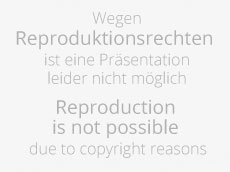

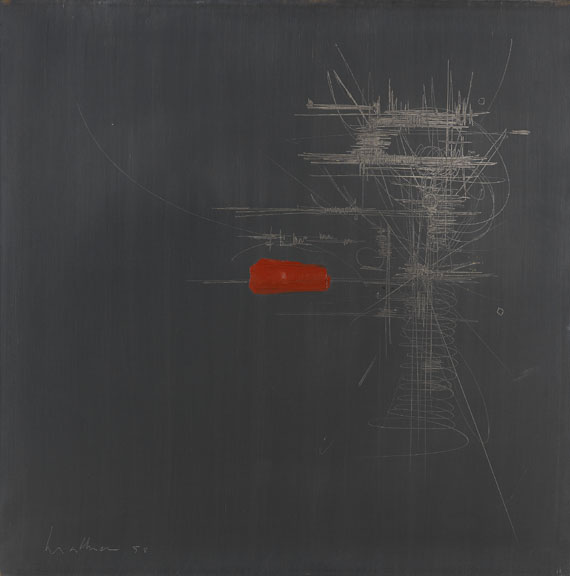
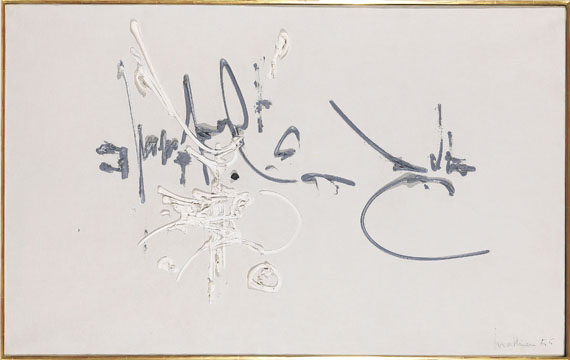



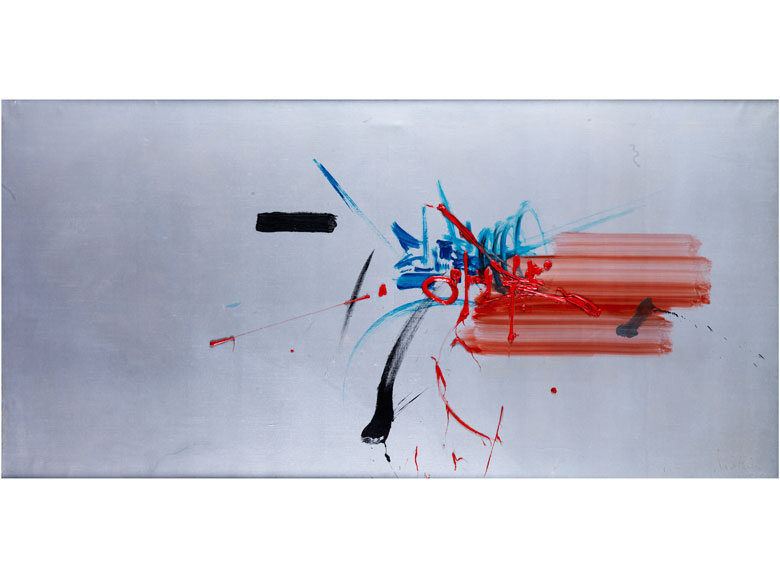
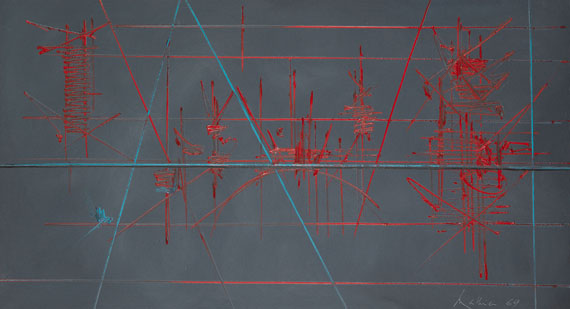


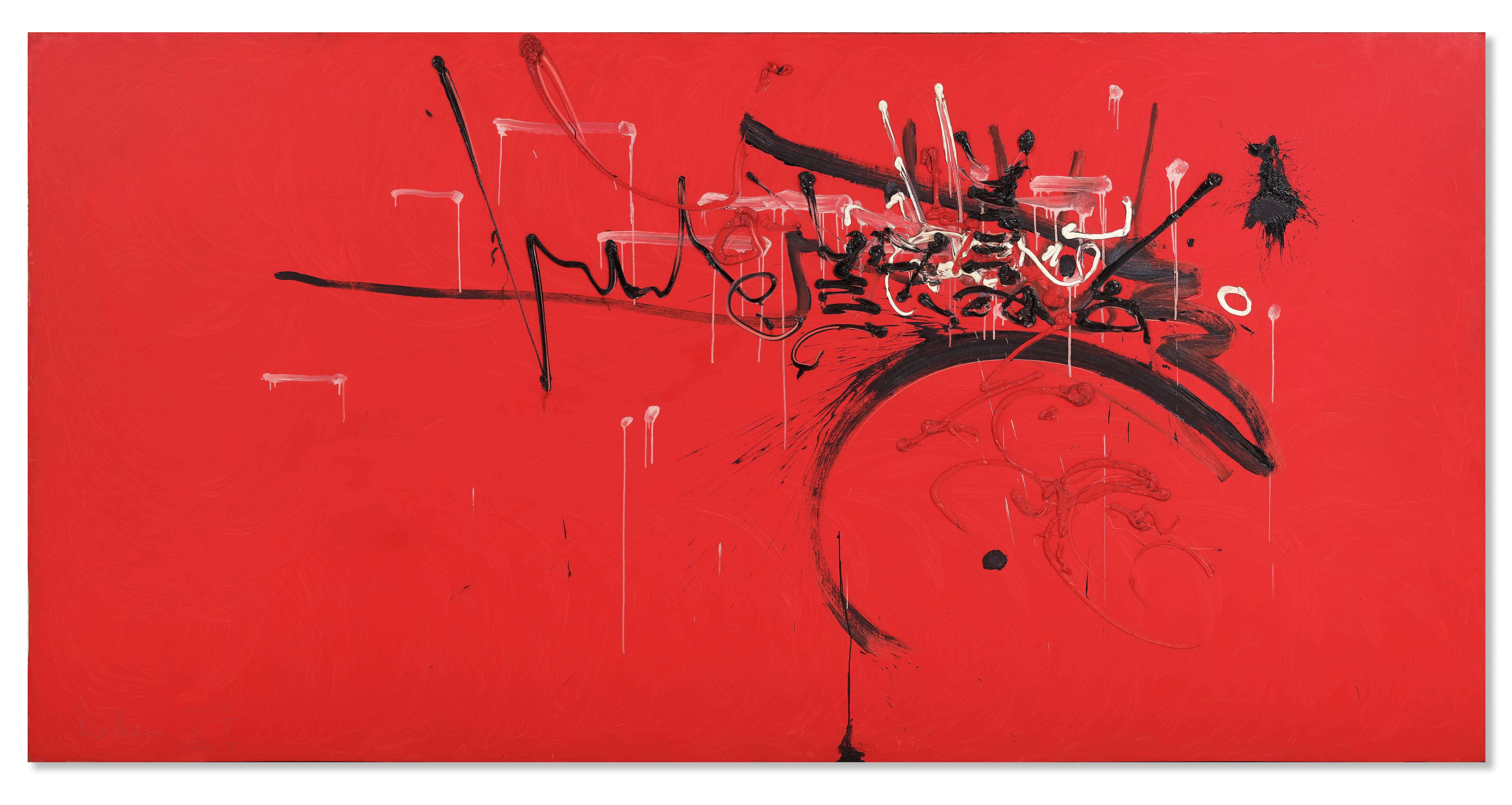

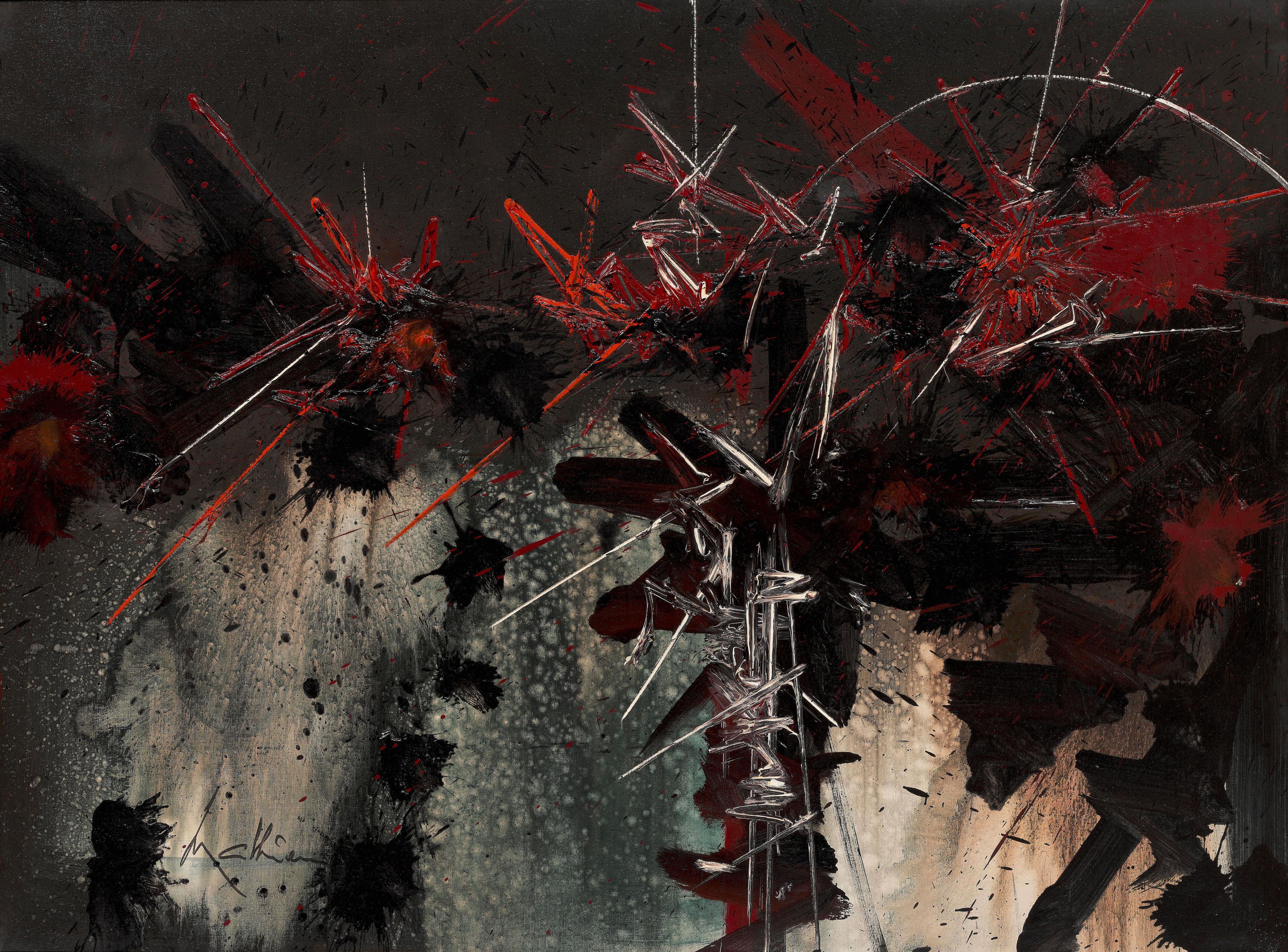
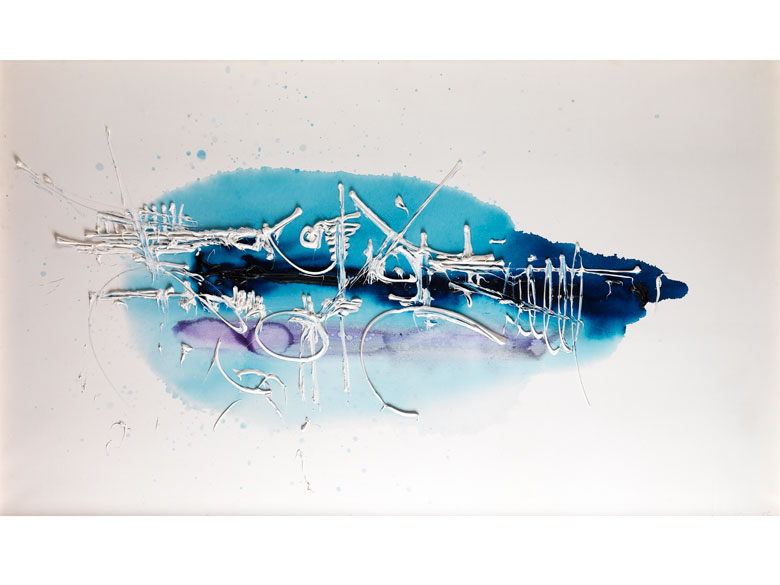
Testen Sie LotSearch und seine Premium-Features 7 Tage - ohne Kosten!
Lassen Sie sich automatisch über neue Objekte in kommenden Auktionen benachrichtigen.
Suchauftrag anlegen